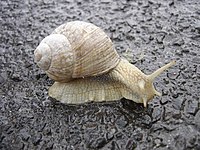
Photo from wikipedia
Background Biomphalaria pfeifferi is the world’s most widely distributed and commonly implicated vector snail species for the causative agent of human intestinal schistosomiasis, Schistosoma mansoni. In efforts to control S.… Click to show full abstract
Background Biomphalaria pfeifferi is the world’s most widely distributed and commonly implicated vector snail species for the causative agent of human intestinal schistosomiasis, Schistosoma mansoni. In efforts to control S. mansoni transmission, chemotherapy alone has proven insufficient. New approaches to snail control offer a way forward, and possible genetic manipulations of snail vectors will require new tools. Towards this end, we here offer a diverse set of genomic resources for the important African schistosome vector, B. pfeifferi. Methodology/Principal findings Based largely on PacBio High-Fidelity long reads, we report a genome assembly size of 772 Mb for B. pfeifferi (Kenya), smaller in size than known genomes of other planorbid schistosome vectors. In a total of 505 scaffolds (N50 = 3.2Mb), 430 were assigned to 18 large linkage groups inferred to represent the 18 known chromosomes, based on whole genome comparisons with Biomphalaria glabrata. The annotated B. pfeifferi genome reveals a divergence time of 3.01 million years with B. glabrata, a South American species believed to be similar to the progenitors of B. pfeifferi which undertook a trans-Atlantic colonization < five million years ago. Conclusions/Significance The genome for this preferentially self-crossing species is less heterozygous than related species known to be preferential out-crossers; its smaller genome relative to congeners may similarly reflect its preference for selfing. Expansions of gene families with immune relevance are noted, including the FReD gene family which is far more similar in its composition to B. glabrata than to Bulinus truncatus, a vector for Schistosoma haematobium. Provision of this annotated genome will help better understand the dependencies of trematodes on snails, enable broader comparative insights regarding factors contributing to susceptibility/ resistance of snails to schistosome infections, and provide an invaluable resource with respect to identifying and manipulating snail genes as potential targets for more specific snail control programs.
Journal Title: PLOS Neglected Tropical Diseases
Year Published: 2023
Link to full text (if available)
Share on Social Media: Sign Up to like & get
recommendations!